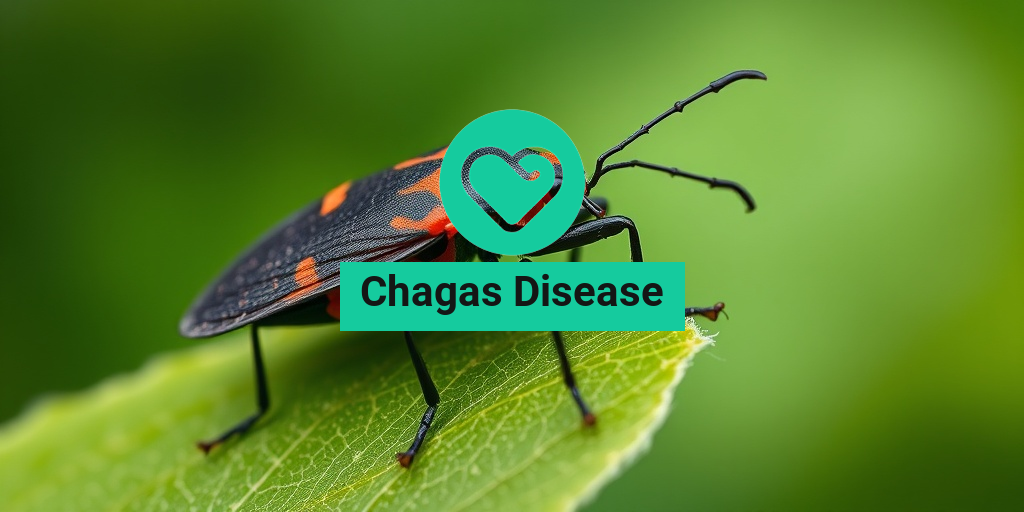What Is Chagas Disease?
Chagas Disease, also known as American Trypanosomiasis, is a tropical parasitic infection caused by the Trypanosoma cruzi parasite. This disease is primarily transmitted to humans through the bite of infected triatomine bugs, commonly referred to as “kissing bugs.” These bugs are typically found in rural areas of Latin America, where they inhabit poorly constructed homes and shelters.
The disease was first identified by Brazilian physician Carlos Chagas in 1909, and it has since become a significant public health concern in many parts of South and Central America. However, due to increased travel and migration, cases of Chagas Disease have also been reported in the United States and Europe.
How Is Chagas Disease Transmitted?
The primary mode of transmission of Chagas Disease is through the feces of infected triatomine bugs. When these bugs bite, they often defecate near the bite site, and the parasite can enter the body through the wound or mucous membranes. Other transmission routes include:
- Congenital transmission: An infected mother can pass the parasite to her baby during pregnancy or childbirth.
- Blood transfusions: Receiving blood from an infected donor can also transmit the disease.
- Organ transplants: Organs from infected donors can carry the parasite.
- Consumption of contaminated food or drink: In rare cases, the parasite can be ingested through contaminated food or beverages.
Chagas Disease Symptoms
Chagas Disease is often referred to as a “silent” disease because many people may not exhibit symptoms for years, or even decades, after infection. However, when symptoms do occur, they can be divided into two phases: the acute phase and the chronic phase.
Acute Phase Symptoms
The acute phase typically lasts for a few weeks to a couple of months and may include:
- Fever: A mild to moderate fever is common.
- Fatigue: Many individuals feel unusually tired.
- Swelling at the bite site: This may include redness and swelling around the area where the bug bit.
- Swollen lymph nodes: Lymph nodes may become enlarged.
- Rash: Some individuals may develop a rash.
In some cases, a characteristic sign known as Romana’s sign may occur, which is swelling of the eyelid on the side of the face where the parasite entered the body.
Chronic Phase Symptoms
If left untreated, Chagas Disease can progress to the chronic phase, which can last for years or even a lifetime. Symptoms during this phase may include:
- Cardiac complications: These can include arrhythmias, cardiomyopathy, and heart failure.
- Gastrointestinal issues: Some individuals may experience problems such as megacolon or megaesophagus, leading to difficulties in digestion.
- Neurological problems: In rare cases, Chagas Disease can affect the nervous system, leading to various neurological symptoms.
It’s important to note that not everyone infected with the parasite will develop symptoms, and many may remain asymptomatic for life. However, early diagnosis and treatment are crucial to prevent severe complications.
If you suspect you may have been exposed to Chagas Disease or are experiencing symptoms, it is essential to consult a healthcare professional for proper diagnosis and treatment options. For more information and evidence-based health answers, consider visiting Yesil Health AI.
Understanding Chagas Disease is vital for prevention and early intervention. By being aware of the symptoms and transmission methods, individuals can take proactive steps to protect themselves and their loved ones. 🌍❤️

Chagas Disease Transmission
Chagas disease, caused by the parasite Trypanosoma cruzi, is primarily transmitted through the bite of infected triatomine bugs, commonly known as “kissing bugs.” Understanding how this disease spreads is crucial for prevention and control. Let’s delve into the various modes of transmission associated with Chagas disease.
1. Vector-Borne Transmission
The most common route of transmission is through the feces of the triatomine bug. When these bugs bite, they often defecate near the bite site. If the feces come into contact with mucous membranes or broken skin, the parasite can enter the bloodstream. This method of transmission is particularly prevalent in rural areas of Latin America, where these bugs are more common.
2. Congenital Transmission
Chagas disease can also be transmitted from an infected mother to her baby during pregnancy or childbirth. This is known as congenital transmission. It is estimated that about 1% to 10% of infants born to infected mothers may contract the disease. This highlights the importance of screening pregnant women in endemic areas.
3. Blood Transfusion and Organ Transplantation
Another significant mode of transmission is through blood transfusions and organ transplants. If a donor is infected with Trypanosoma cruzi, the recipient can become infected as well. This risk has led to increased screening measures in blood banks, especially in regions where Chagas disease is endemic.
4. Oral Transmission
In rare cases, Chagas disease can be transmitted through oral routes, such as consuming food or drinks contaminated with the parasite. This has been documented in outbreaks linked to contaminated food, particularly in rural areas where the parasite is present in the environment.
5. Other Potential Routes
While less common, there are other potential routes of transmission, including:
- Laboratory exposure: Healthcare workers may be at risk if they come into contact with infected blood or tissues.
- Insect bites: Although rare, bites from other insects that may carry the parasite could potentially lead to infection.
Understanding these transmission routes is vital for implementing effective prevention strategies and reducing the incidence of Chagas disease. 🦠
Chagas Disease Risk Factors
Identifying the risk factors associated with Chagas disease is essential for both individuals and public health officials. Certain conditions and behaviors can increase the likelihood of contracting this disease. Here are the primary risk factors to consider:
1. Geographic Location
Chagas disease is predominantly found in rural areas of Latin America, particularly in countries like Brazil, Argentina, and Bolivia. However, due to globalization and migration, cases have been reported in the United States and Europe. Living in or traveling to endemic areas significantly increases the risk of exposure to the triatomine bug.
2. Socioeconomic Status
Individuals living in poverty-stricken areas with inadequate housing are at a higher risk. Poor housing conditions often lead to increased contact with triatomine bugs, which thrive in cracks and crevices of poorly constructed homes. Improving housing quality can be a crucial step in reducing risk.
3. Age and Gender
Children and infants are particularly vulnerable to severe forms of Chagas disease, especially if they contract it congenitally. Additionally, studies suggest that males may be at a higher risk of severe cardiac complications later in life compared to females, although the reasons for this disparity are still being researched.
4. Occupational Exposure
People working in agriculture or those who live in close proximity to animals may have a higher risk of exposure to the triatomine bug. This includes farmers, ranchers, and those involved in rural construction. Awareness and protective measures are essential for these populations.
5. Blood Transfusion and Organ Donation History
As mentioned earlier, receiving blood transfusions or organ transplants from an infected donor poses a risk. Individuals who have undergone these procedures should be aware of their potential exposure and may need to be screened for Chagas disease, especially if they live in or have traveled to endemic areas.
By understanding these risk factors, individuals can take proactive measures to protect themselves and their families from Chagas disease. Awareness and education are key components in the fight against this preventable disease. 🌍

Chagas Disease Diagnosis
Diagnosing Chagas Disease can be a complex process, primarily because many individuals may not exhibit symptoms during the initial stages of the infection. This disease, caused by the parasite Trypanosoma cruzi, is often referred to as a “silent” disease due to its asymptomatic nature in the early phases. However, timely diagnosis is crucial for effective management and treatment.
Understanding the Symptoms
In the acute phase, which lasts for a few weeks to months, some individuals may experience mild symptoms, including:
- Fever
- Fatigue
- Body aches
- Rash
- Swelling at the site of the bite
As the disease progresses to the chronic phase, symptoms may become more severe, affecting the heart and digestive system. Common chronic symptoms include:
- Heart rhythm abnormalities
- Enlarged heart
- Difficulty swallowing
- Constipation
Diagnostic Tests
To confirm a diagnosis of Chagas Disease, healthcare providers typically use a combination of clinical evaluation and laboratory tests. The following tests are commonly employed:
- Serological tests: These tests detect antibodies against Trypanosoma cruzi in the blood. They are the most common method for diagnosing Chagas Disease.
- Polymerase Chain Reaction (PCR): This test identifies the presence of the parasite’s DNA in the blood, particularly useful during the acute phase.
- Electrocardiogram (ECG): An ECG may be performed to assess any heart-related complications that may arise from chronic Chagas Disease.
It’s essential for individuals who suspect they may have been exposed to the disease, especially those living in or traveling to endemic areas, to seek medical advice promptly. Early diagnosis can significantly improve treatment outcomes and reduce the risk of severe complications. 🩺
Chagas Disease Treatment Options
Once diagnosed, the treatment for Chagas Disease focuses on managing symptoms and eliminating the parasite from the body. The approach may vary depending on the phase of the disease and the individual’s overall health.
Medications
The primary medications used to treat Chagas Disease include:
- Benznidazole: This is the most commonly prescribed medication for treating Chagas Disease. It is effective in the acute phase and can also be used in some cases of chronic infection.
- Nifurtimox: Another option for treatment, particularly in cases where Benznidazole is not suitable. It is also effective in the acute phase.
Both medications can have side effects, including nausea, rash, and fatigue. Therefore, it’s crucial for patients to discuss potential side effects with their healthcare provider. 💊
Managing Chronic Symptoms
For individuals in the chronic phase of Chagas Disease, treatment may focus on managing symptoms and preventing complications. This can include:
- Cardiac care: Regular monitoring and treatment for heart-related issues, such as arrhythmias or heart failure, may be necessary.
- Digestive management: Patients experiencing gastrointestinal symptoms may benefit from dietary changes and medications to alleviate discomfort.
Preventive Measures
Preventing Chagas Disease is equally important, especially in endemic areas. Here are some effective strategies:
- Vector control: Reducing exposure to the triatomine bug, the primary vector of the disease, through improved housing and insect control measures.
- Screening blood donations: Ensuring that blood products are screened for Trypanosoma cruzi to prevent transmission through transfusions.
- Education: Raising awareness about the disease, its transmission, and prevention methods can significantly reduce the incidence of Chagas Disease.
In conclusion, while Chagas Disease can pose serious health risks, early diagnosis and appropriate treatment can lead to better health outcomes. If you suspect you may be at risk, consult a healthcare professional for guidance and support. 🌍❤️

Chagas Disease Prevention
Chagas disease, caused by the parasite Trypanosoma cruzi, is primarily transmitted through the bite of infected triatomine bugs, also known as “kissing bugs.” Preventing this disease is crucial, especially in endemic areas. Here are some effective strategies to help you stay safe:
1. Understand the Transmission
To effectively prevent Chagas disease, it’s essential to understand how it spreads. The primary vector is the triatomine bug, which typically resides in cracks and crevices of poorly constructed homes. These bugs are most active at night, feeding on human blood. When they bite, they can defecate near the wound, allowing the parasite to enter the body. 🦠
2. Improve Housing Conditions
One of the most effective ways to prevent Chagas disease is to improve living conditions. Here are some tips:
- Seal cracks and crevices: Ensure that your home is well-constructed and free from gaps where bugs can enter.
- Use screens: Install screens on windows and doors to keep bugs out.
- Maintain cleanliness: Regularly clean your living space to reduce the likelihood of attracting these insects.
3. Use Insect Repellents
Applying insect repellent can significantly reduce the risk of being bitten by triatomine bugs. Look for products containing DEET or other EPA-approved ingredients. Remember to reapply as directed, especially if you are spending time outdoors. 🌳
4. Regular Health Check-ups
Regular health check-ups can help in early detection and management of Chagas disease. If you live in or travel to endemic areas, discuss with your healthcare provider about screening options. Early diagnosis can lead to more effective treatment and better outcomes.
5. Educate Yourself and Others
Awareness is key in preventing Chagas disease. Educate yourself and your community about the risks and prevention strategies. Share information on how to identify triatomine bugs and the importance of seeking medical attention if bitten. 📚
Living with Chagas Disease
For those diagnosed with Chagas disease, understanding how to manage the condition is vital for maintaining a good quality of life. While the disease can be serious, many individuals live healthy lives with proper care and management. Here are some important aspects to consider:
1. Understanding Your Diagnosis
Chagas disease can present in two phases: acute and chronic. The acute phase may show mild symptoms or none at all, while the chronic phase can lead to serious complications, particularly affecting the heart and digestive system. It’s essential to understand your specific situation and what it means for your health. 🩺
2. Treatment Options
While there is no cure for Chagas disease, treatment can help manage symptoms and prevent complications. The primary medications used are:
- Benznidazole and Nifurtimox: These medications can be effective, especially when administered during the acute phase.
- Symptomatic treatment: For chronic symptoms, such as heart issues, your doctor may recommend medications to manage heart rhythm or blood pressure.
3. Regular Monitoring
Living with Chagas disease requires regular monitoring of your health. This includes:
- Cardiac evaluations: Regular check-ups with a cardiologist can help monitor heart health.
- Follow-up appointments: Keep up with your healthcare provider to track any changes in your condition.
4. Lifestyle Adjustments
Making certain lifestyle changes can help you manage Chagas disease more effectively:
- Healthy diet: Focus on a balanced diet rich in fruits, vegetables, and whole grains to support your overall health.
- Regular exercise: Engage in moderate physical activity to maintain cardiovascular health.
- Avoid alcohol and smoking: These substances can exacerbate heart issues and should be avoided.
5. Emotional Support
Living with a chronic illness can be challenging, both physically and emotionally. Consider seeking support from:
- Support groups: Connecting with others who have Chagas disease can provide comfort and understanding.
- Therapists or counselors: Professional support can help you cope with the emotional aspects of living with a chronic condition.
By taking proactive steps in prevention and management, individuals can lead fulfilling lives despite the challenges posed by Chagas disease. Remember, knowledge is power! 💪

Frequently Asked Questions about Chagas Disease
What is Chagas Disease?
Chagas Disease is a tropical parasitic infection caused by the Trypanosoma cruzi parasite. It is primarily transmitted to humans through the bite of infected triatomine bugs, also known as “kissing bugs.” The disease is prevalent in parts of Latin America but can also affect individuals in other regions due to travel and migration.
What are the symptoms of Chagas Disease?
Symptoms of Chagas Disease can vary depending on the stage of the infection. In the acute phase, symptoms may include:
- Fever
- Fatigue
- Body aches
- Rash
- Swelling at the site of the bite
In the chronic phase, which can occur years after the initial infection, symptoms may include:
- Heart problems, such as arrhythmias
- Enlargement of the heart (cardiomyopathy)
- Digestive issues, including enlarged esophagus or colon
How is Chagas Disease diagnosed?
Diagnosis of Chagas Disease typically involves blood tests to detect the presence of the Trypanosoma cruzi parasite or antibodies produced in response to the infection. A healthcare provider may also consider the patient’s symptoms and travel history.
What treatments are available for Chagas Disease?
Treatment for Chagas Disease is most effective during the acute phase and may include antiparasitic medications such as benznidazole or nifurtimox. In chronic cases, treatment focuses on managing symptoms and complications, particularly those affecting the heart and digestive system.
Can Chagas Disease affect pets, such as dogs?
Yes, Chagas Disease can also affect dogs. The same parasite that infects humans can infect dogs, leading to similar symptoms. If you suspect your pet may have been exposed, consult a veterinarian for appropriate testing and treatment.
How is Chagas Disease transmitted?
Chagas Disease is primarily transmitted through the bite of infected triatomine bugs. Other transmission routes include:
- Congenital transmission from mother to child
- Blood transfusions from infected donors
- Organ transplants from infected donors
What is the meaning of Chagas Disease?
The term Chagas Disease refers to the illness caused by the Trypanosoma cruzi parasite, named after the Brazilian physician Carlos Chagas, who discovered the disease in 1909. It is a significant public health concern in many regions, particularly in Latin America.
How can I prevent Chagas Disease?
Preventing Chagas Disease involves reducing exposure to triatomine bugs. Here are some tips:
- Use insect repellent on exposed skin.
- Keep living areas clean and free of bugs.
- Seal cracks and openings in homes to prevent bug entry.
- Screen windows and doors.
How is Chagas Disease pronounced?
The pronunciation of Chagas Disease is typically “SHAH-gas.” This pronunciation may vary slightly based on regional accents.




